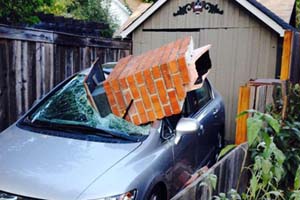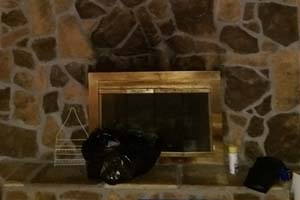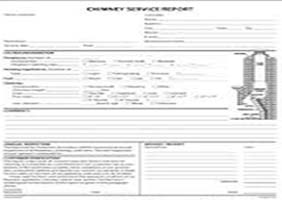Signs of a Chimney Fire
September 12, 2014 in Signs of a Chimney Fire

If you have
just purchased a home, the
inspection report should include
details about the chimney’s past
including any fires that might
have happened.
Not every chimney fire
will leave the same set of signs
and effects, but because a fire
creates conditions so
dramatically different from
those of a normal heating
operation it is likely that
every fire will cause changes in
the physical state of both the
creosote deposits and the
chimney itself. When
looking at your chimney, here
are signs that it suffered a
fire outbreak in the past:
- The chimney cap is distorted or looks burned or warped such as the one in the photo.
- The damper is warped or the metal handle of the damper is warped.
- There is foamy creosote buildup that expanded and is coating the liner and firebox. It will have bubbles in it from where the burning occurred, and sometimes it will appear to have colors rather than be just plain black.
- The presence of non-uniformity in the flue is one of the more distinctive signs of a chimney fire. This means the flue has tiles that are partially broken or crumbled and smoke stained. Or, there is thick creosote bubbling on one side of the flue compared to the other.
- You may see chunks of creosote on your roof or falling into your fireplace.
- You see damage on the exterior of your house. The roof or chimney’s masonry looks damaged by heat or cracked. If there is evidence of smoke stains around the cracks, there was definitely a fire.
The conditions
needed for ignition of a chimney
fire are essentially the same as
those necessary to start any fire:
adequate fuel, heat,
and oxygen. Chimney fires are
ignited when these elements come
together unbeknownst to the
homeowner. A fire is
avoided when one or more is
deficient. The manner in which these
factors are manifested accidently in
a chimney is worth examining to help
with future prevention.
Structural
issues or cracks in your chimney
liner allow high temperatures and
embers to find their way into
combustible areas in walls, the
roof, or attics and start a fire.
Chimney fires also occur when
creosote, the by-product of burning
wood, catches on fire inside of the
chimney. This is
because creosote is highly
combustible and it can easily
ignite. Chimney fires
caused by creosote are ignited by
direct contact of flames issuing
from the fireplace or appliance onto
deposits of creosote, or from
non-burning flue gases that are hot
enough to raise the creosote to its
ignition temperature, or from sparks
or embers carried from the fireplace
that have settled on creosote
deposits and started a fire.
Take some
preventive steps to help avoid a
chimney fire from starting in the
first place. Use the right
firewood in your fireplace or
wood-burning stove when you are
burning wood, which means wood that
has had about a year to dry out.
No freshly cut wood should be used
because it is still retaining
moisture that contributes to a lower
temperature fire that creates more
smoke and creosote. Do not
burn anything else in your fireplace
such as trash, cardboard, paper, etc.
Make sure you have your damper open
and an adequate draft when lighting
a fire and keep everything sealed up
when your fireplace or heating
appliance is not in use. Most
importantly, you need a professional
chimney sweep to annually clean and
inspect the inside of your chimney.
They will remove the buildup of
creosote and check for any other
hazards that could potentially cause
a chimney fire.



